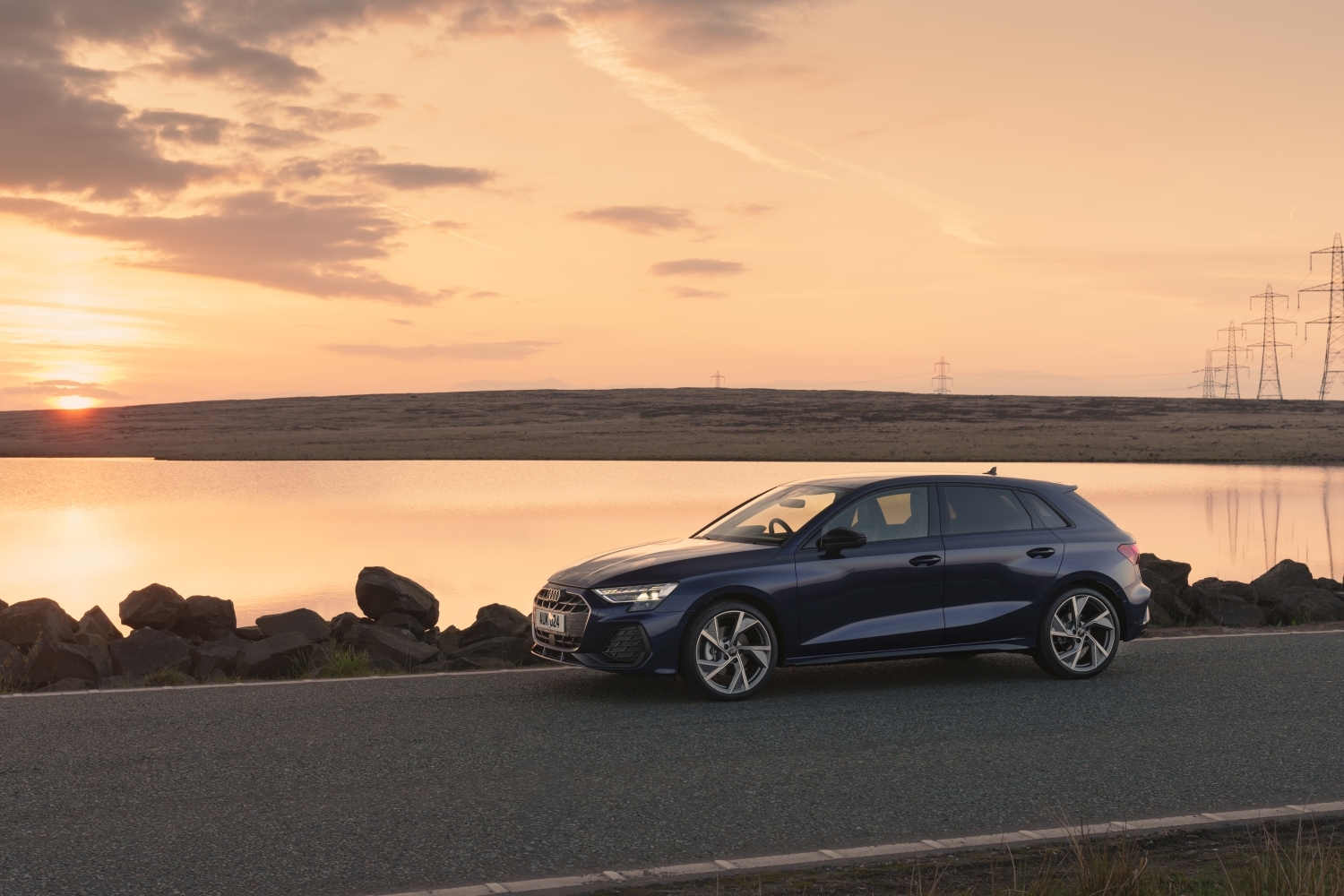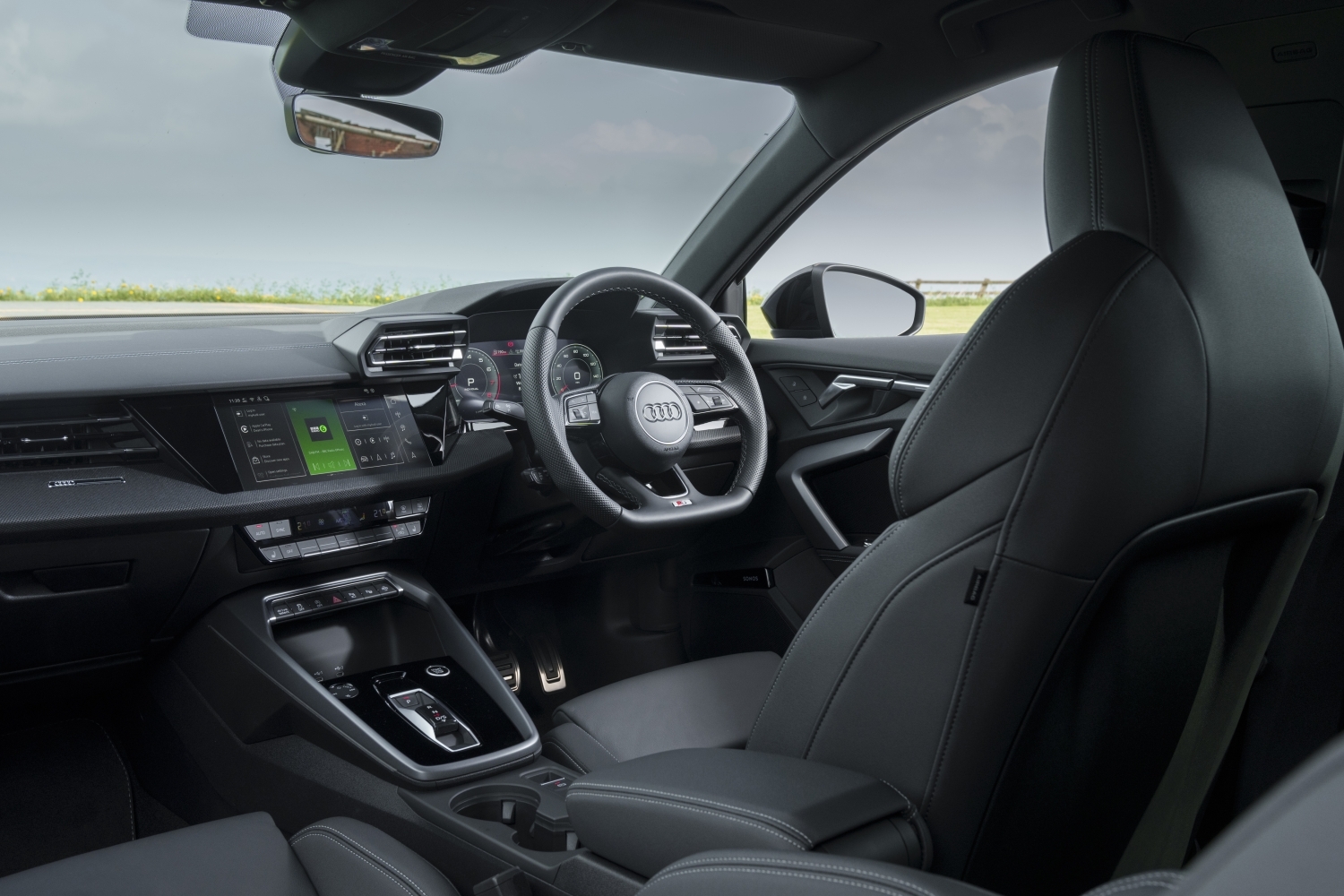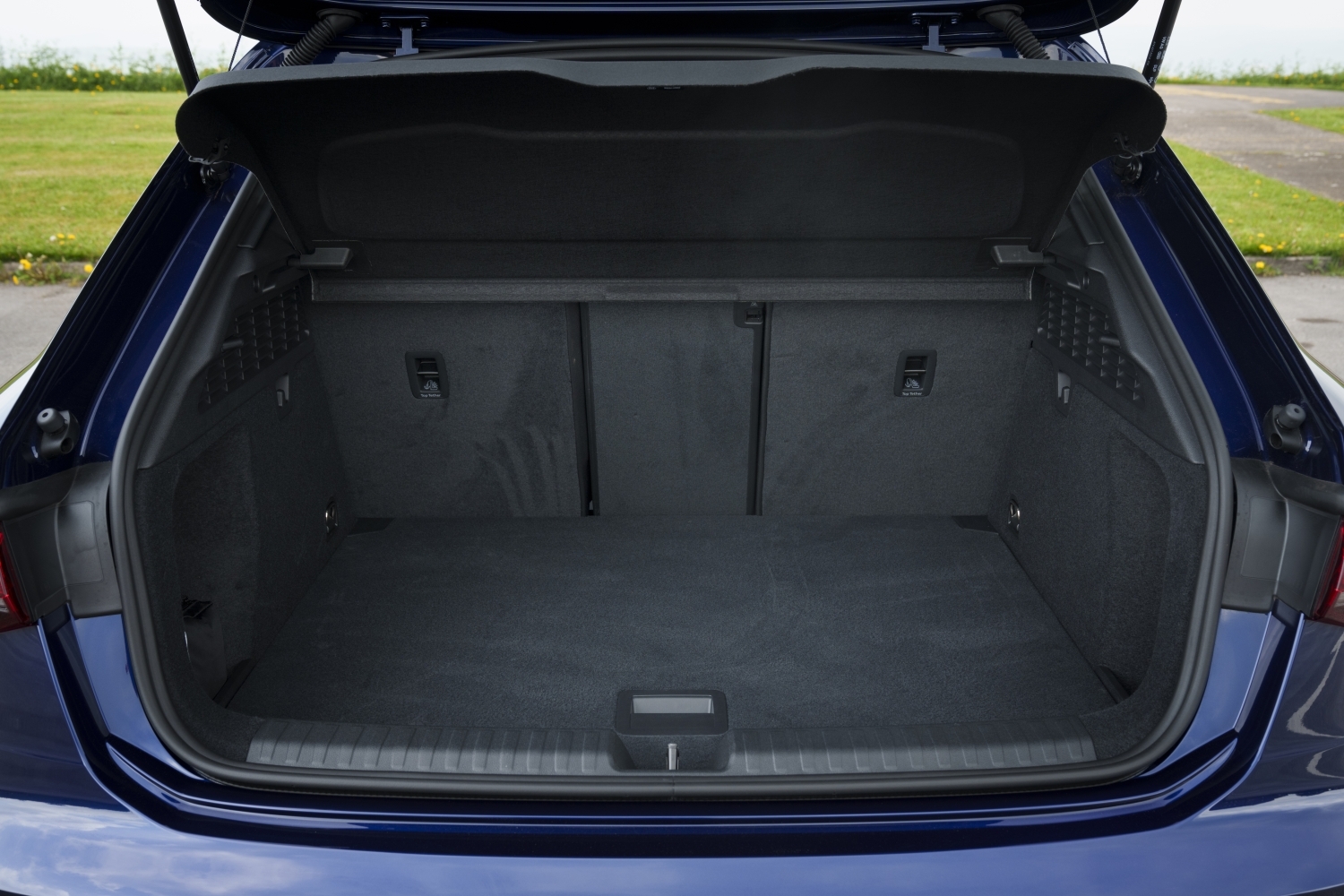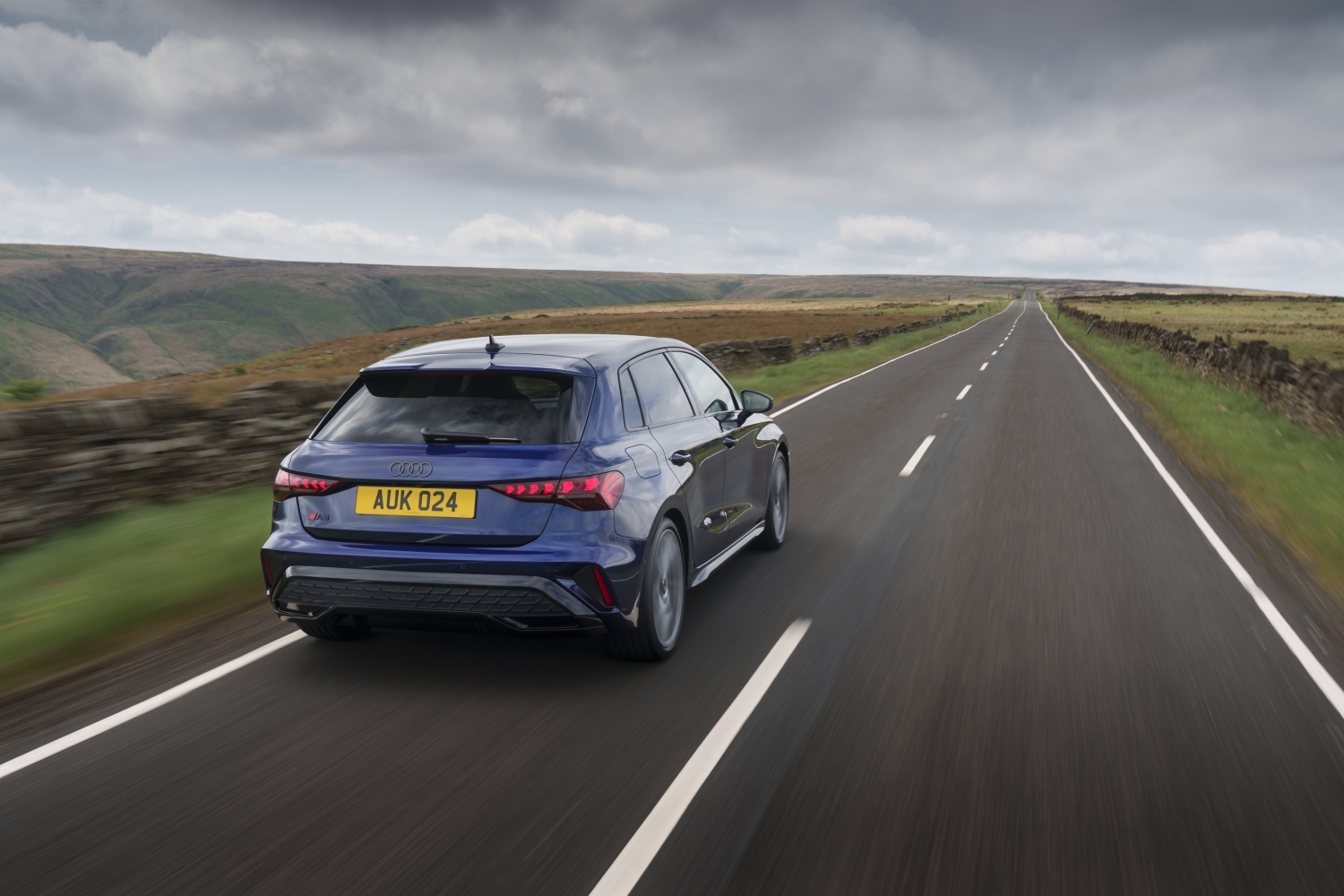
RAC sale – up to 33% off*
• Roadside cover from £5.29 a month†
• We get to most breakdowns in 60 mins or less
• Our patrols fix 4/5 breakdowns on the spot

The Audi A3 Sportback is a long-established premium hatch that received a series of updates in 2024. Does it still have a competitive edge? Lawrence Allan drives it to find out.
Things you'll like
- Comfortable, quiet and decent to drive
- User-friendly interior design
- Decent practicality
Things to consider
- A 1 Series is even nicer to drive
- Not the most affordable choice
- Gearbox response could be better
What is the Audi A3?
Enjoying nearly three decades of continuous success, the Audi A3 is regarded as the founding father of the compact premium hatchback – a sector with vast global appeal.
Prior to the first-generation A3’s arrival in 1996, there really wasn’t much choice for the aspirational in the hatchback class. Sure, the moderately successful BMW 3 Series Compact had been around for a bit, but that was little more than a hastily shortened 3 Series saloon. Other than that, a high-end version of the VW Golf was as premium as it got.
The first A3 was timed to arrive just before the Mercedes-Benz A-Class, and the two cars have been locked in competition ever since. BMW upped the ante when the 1 Series arrived in 2004 and, aside from low-level competition from brands like Volvo and Lexus, it’s the German ‘big three’ that have dominated the sector ever since.
Now in its fourth generation, the Audi A3 is bigger, safer, faster and more tech-loaded than ever before. But with Mercedes and BMW both having facelifted their offerings, a minor 2024 update aims to restore its competitive edge. Is it still the kind of the premium hatchback? We’ll find out in this review.
Verdict: is the Audi A3 a good car?
The Audi A3 remains a solid and capable all-rounder, and although the recent updates haven’t transformed it there’s still plenty of appeal to be found. A comfortable, spacious and user-friendly interior combines with a good ride and handling balance to give the A3 plenty of strings to its bow. A 1 Series is more fun to drive, and an A-Class has the edge for glitz and glamour, but the Audi should still be on your shopping list.
Pricing, specs & rivals: How much does the Audi A3 cost?
Like many alternatives, Audi’s A3 range used to baffle buyers with a bewildering array of trim levels and engine options. Today things are much simpler, primarily to reduce production complexity and cost.
You get three core trim levels: entry-level Sport, mid-spec S line and high-flying Black Edition. Bar any special editions, that’s your lot. Prices start at just under £30,000 (correct as of late 2024) for an A3 Sport model with the base 30 TFSI petrol engine.
Other engine options include the more powerful 35 TFSI petrol, a 35 TDI diesel (now the sole oil-burning option in the range) and a pair of plug-in hybrids badged 40 TFSI e and 45 TFSI e. That’s not including the performance variants (The S3 hot hatch and RS3 mega hatch) which we’ll review separately.

Sport trim is hardly bare-bones, with standard kit including heated front seats, auto lights and wipers, tri-zone climate control, cruise control, power folding mirrors, 17-inch alloys and an electrochromic rear-view mirror. As all A3s get the same basic cabin tech, too, we reckon this’ll suit most needs.
Even so, S line trim delivers a more Audi-like aesthetic and driving experience for around £2,300 extra. With bigger 18-inch alloys, sportier bumpers and interior details, sports suspension and multi-colour ambient lighting we can see why most people upgrade.
Black Edition trim is harder to justify. It’s not available on the 30 TFSI, bumping the price up to over £35,000 while bringing kit such as black exterior detailing, 19-inch wheels, puddle light logo projectors.
The A3 is still locked in an eternal battle with the closely-matched BMW 1 Series and Mercedes-Benz A-Class. But more mainstream alternatives have pushed upmarket in recent years: namely the Honda Civic, Mazda 3 and Peugeot 308. Also consider the closely related but cheaper VW Golf.
Audi A3: Interior comfort, quality & technology
We’ve become so used to giant touchscreens and dazzling digital tech that the cabin of the A3 almost seems understated in that respect. Certainly, that is, compared with the recently updated 1 Series and overtly showy A-Class.
Ignore the somewhat uninspiring design, though, because the A3’s skill is that it blends enough modern gadgetry with old-school user-friendliness. The touchscreen still plays the main role in controlling most functions, but it’s flanked by easy shortcuts and complemented by physical climate control switchgear, buttons for things like the drive mode selector and tactile steering wheel switchgear.
Put simply, it’s a doddle to operate on the move compared to a lot of rival interiors. Quality takes a small but noticeable improvement with the 2024 update, too, with new recycled textile fabric for the main vertical dash panel instead of plastic along with improved ambient lighting and new door panel inserts.
It’s good, but unlike the previous-generation A3 it doesn’t set the standard for premium finish. We reckon the 1 Series has fewer sub-par cabin plastics, while even the Mazda 3 feels that bit plusher inside.
Still, the Audi’s driving position is excellent. There’s loads of adjustment in the seat and wheel, a comfortable multi-adjustable armrest and, as of 2024, standard adjustable lumbar support across the range – a boon on long drives. Forward visibility is good, too, even if the rear view back is marred by thick pillars.

Infotainment, sat-nav, stereo and connectivity
Every A3 regardless of trim comes with a 10.1-inch touchscreen. It’s nestled within the dash itself rather than sticking out of the dash top like some of the newer VW Group designs – lots of people prefer this more neatly integrated approach. You also get Audi’s 10.25-inch Virtual Cockpit display across the range, which remains as impressively crisp and customizable as we’ve come to expect from the brand.
As for the touchscreen itself? It’s not as visually dazzling as the systems on the latest A-Class and 1 Series, sure, with somewhat muted graphics and some small icons, but it’s easy to get along with and responds crisply to inputs. We reckon its less complicated to operate on the move than the BMW and Mercedes-Benz.
Wireless Apple CarPlay and Android Auto feature for connectivity, as does in-built Amazon Alexa voice control and Audi’s MMI navigation. The front gets a USB-A and USB-C ports for smartphone charging, while the rears are USB-C only. A wireless phone charger also features as standard kit.
The optional Technology Pack also adds a reversing camera (something we’d expect to be standard at this price point) along with a head-up display and an upgraded Sonos 15-speaker sound system with 680 watts. The standard 10-speaker system isn’t exactly tinny, however.
How practical is the Audi A3?
The A3 is relatively compact by today’s family car standards, particularly now the market is biased so heavily in favour of SUVs. Its dimensions are 4.35m in length, 1,44m in height and 1.82m in width (excluding mirrors). That’s slightly wider, shorter and lower than the 1 Series.
Even so, the A3 delivers ample practicality for a small family, or drivers with regular passengers. Tall adults find a good level of comfort thanks to plenty of leg and shoulder room up front, and while something like a Skoda Octavia is significantly roomier in the back, a pair of six footers will find enough head and legroom to avoid complaint.
Three adults across the rear is a bit of a squeeze – the A3 is wide enough to cope, but the raised middle seat means even average-sized adults will be close to the roof lining and, unlike an EV, there’s a chunky transmission tunnel taking up foot room. Overall, though, it’s comparable to its closest rivals.
Those with child seats can make use of two ISOFIX points in the outer rear seats, and although a third point in the front passenger seat isn’t standard Audi will let you add one for free with a new order.
Storage and boot space
Oddment storage in the A3 is decent but nothing to write home about. Up front, the door bins are a decent size, as is the glovebox, while there’s a couple of cupholders, a small storage area for your phone and wallet in from of the gearstick, and a larger one under the centre armrest.
The rear door pockets are much smaller but will still take 500ml water bottles with ease, while there are flexible nets in the front seatbacks. It’s worth noting that base Sport trim doesn’t have a rear centre armrest, which is included in all higher trims and comes with another pair of cupholders.
Sport trim also misses out on the more flexible 40/20/40 rear seat folding found on S line and above, which is a shame as it adds a good level of versatility. No A3s offer siding or reclining rear seats to let you juggle boot or passenger space, which is one reason family buyers might want an Audi Q3 instead.
Petrol and diesel A3s offer a boot with 380 litres of seats-up capacity – identical to a 1 Series and more than an A-Class. Again, an equivalent family SUV offers more space, but the Audi makes good use of its boot area with a wide opening. A standard adjustable boot floor also reduces the load lip while leaving a useful chunk of underfloor storage, too.

An important drawback of the plug-in hybrid A3 models is the reduced boot capacity. Both have a capacity of just 280 litres – less than an Audi A1 – because the underfloor storage is removed and the boot floor is raised. That’s a significant drop in practicality.
Performance & drive: What is the Audi A3 like on the road?
The entry-level A3 TFSI 30 engine used to be a 1.0-litre three-cylinder turbo petrol, but with the 2024 update that’s been binned in favour of the venerable 1.5 TFSI four-cylinder detuned to 115hp. Downsizing is no longer in fashion, it seems.
There’s no doubt that the 1.5 is also smoother and more in-keeping with the A3’s premium air, even if it still gets a bit boomy and coarse at high revs. Our all-round choice is the 35 TFSI, though, which is the same unit producing 150hp and a glug more torque. Its performance (a 0-62mph time of 8.1 seconds rather plays the 30 TFSI’s 9.7 seconds) is much more appropriate at this price point – ample, though hardly exciting.
There’s also a 2.0-litre four-cylinder 35 TDI diesel with the same power output as the 35 TFSI, but more torque. Yes, Audi persists in offering a diesel, even though it’ll make up a dwindling number of sales. We’ve yet to try it, but as the official economy gains are marginal we reckon you’ll be better off with the petrols.
Both petrols are available to order with either a six-speed manual gearbox or seven-speed S tronic dual-clutch automatic – the latter being mostly smooth but not as quick to shift as older DSG systems. The diesel is auto-only. Confusingly, only the 35 TFSI auto comes with Audi’s 48-volt mild hybrid system, which is the version we tried.
The system recoups energy under braking or coasting, using it to smooth over the stop/start tech and provide a little boost under low-speed acceleration. It’ll also allow the engine to shut off when you lift off and coast, which works well in some situations. Other times it’ll cut the engine just when you need it to deliver, resulting in a split-second delay harming your ability to pull smartly away from a junction.
Later in the year there will also be a pair of plug-in hybrids: the 204hp 40 TFSI e and 245hp 45 TFSI e. These have had substantial improvements including a bigger battery pack enabling an impressive all-electric range of up to 88 miles. We’ll report back once we’ve tried them.
Power, 0-62mph times
- Audi A3 30 TFSI: 115hp/0-62mph: 9.7 seconds
- Audi A3 35 TFSI: 150hp/0-62mph: 8.1 seconds
- Audi A3 35 TDI: 150hp/0-62mph: 8.1 seconds
Ride and handling
Gone are the days when Audi’s hatch trailed BMW’s when it comes to the driving experience. The latest A3 is an impressively capable all-rounder that blends comfort and handling composure really well.
Entry-level Sport models make do with a basic torsion beam rear suspension set-up, while S line and Black Edition models benefit from a fancier multi-link arrangement and firmer springs and dampers.
That doesn’t mean Sport models are a poor relation – they still manage to smooth off the worst potholes and stay stable in the bends. But the sportier set-up delivers an extra layer of sophistication to the way the car flows down the road, even despite a slightly firmer edge to the low-speed ride.
There’s loads of grip, precise and confidence-inspiring steering and a feeling that the A3 will remain composed no matter what you throw at it. A Ford Focus might be more playful and engaging, while the 1 Series has quicker steering, but we’re talking small differences you’ll probably not care about in normal driving. Overall, though, the Audi rides and handles with a more premium air than the A-Class.

Noise and refinement
Audi recognises that a lot of A3s spend most of their time cruising up and down motorways from meeting to meeting, so the A3 is about as refined as hatchbacks get. Wind noise is very low (lower than the A-Class) and the suspension stays commendable quiet on rough roads. The bigger wheels of S line and Black Edition trim do introduce some road roar over poor surfaces, but overall the A3 is quieter than its key competitors.
Euro NCAP: is the Audi A3 a safe car?
The A3 fits the bill when it comes to keeping your loved ones safe, achieving the maximum five-star rating when tested by safety experts Euro NCAP back in 2020. Today’s test is more stringent still, but much of that focus is on safety assist technology rather than the car’s performance in a crash.
The A3 is on a par with the 1 Series for overall category scores, although the BMW boasts even better child occupant protection. While all three received the top star rating, it’s the Mercedes-Benz A-Class that sets the class standards with adult occupant, child occupant and vulnerable road used scores all at 90% or above.
The expected roster of safety systems – namely automatic emergency braking with collision warning, pedestrian and cyclist detection, lane departure warning, traffic sign recognition and a driver drowsiness warning. The A3 doesn’t have full camera-based driver monitoring like more recently launched models, however, while adaptive cruise control isn’t standard either.
Running costs and fuel economy
The relentless efficiency drive means that it’s impossible to buy a thirsty Audi A3 today – models such as the powerful but relatively inefficient 2.0 TSI petrol have been ditched in the update.
The entry-level 30 TFSI manages an official WLTP figure of up to 50.4mpg combined with the manual gearbox in Sport trim – bear in mind that the bigger wheels of S line drop this figure to 47.9mpg. Interestingly, the S tronic auto boast an even higher official figure of up to 53.3mpg, or 50.4mpg in S line form.
35 TFSI models officially claim identical figures to the lesser unit. Meanwhile the auto-only diesel manages up to 57.6mpg combined – a respectable figure, but not a huge enough jump over the petrols to justify it for all but high mileage drivers.
Strangely, the diesel also emits fractionally more CO2 than the petrols, too, according to Audi’s figures. Perhaps it’s a result of diesels falling out of favour with new buyers, resulting in a lack of engine development for the fuel.
Elsewhere, the A3 doesn’t command a premium over ‘lesser’ hatches in terms of running costs. While those looking to lease a new one will be less interested, official data suggests that the Audi holds its value after three years just as well as equivalents from BMW and Mercedes.
How much does the Audi A3 cost to insure?
Despite the premium badge and image the A3 shouldn’t prove much more expensive to insure than the related VW Golf – if at all. An entry-level 30 TFSI Sport sits in insurance group 15 (fractionally lower than the cheapest A-Class or 1 Series) although this quickly ramps up to group 20 and beyond with higher specs and more powerful engines.
Audi A3 FAQs
Is the Audi A3 a good car?
We reckon the Audi A3 is a good all-round car whether you’re looking for a solid small family car, a classy commuter car or a more upmarket alternative to the hatchback norm. It’s well built, decent to drive and fuel-efficient.
How much does the Audi A3 cost?
Prices for the Audi A3 Sportback start from around £29,500 for Sport trim, While you’ll need closer to £32,000 for an S line and £35,000 for a Black Edition. Used versions of the latest A3 can be found from as little as £10,000, however.
Is the Audi A3 expensive to maintain?
While the cost of maintenance depends on several factors, the Audi A3 features well-proven mechanicals that have been widely used in the VW Group. The price of parts shouldn’t be much more expensive than in the related VW Golf, although you may pay a labour premium at Audi dealers.











